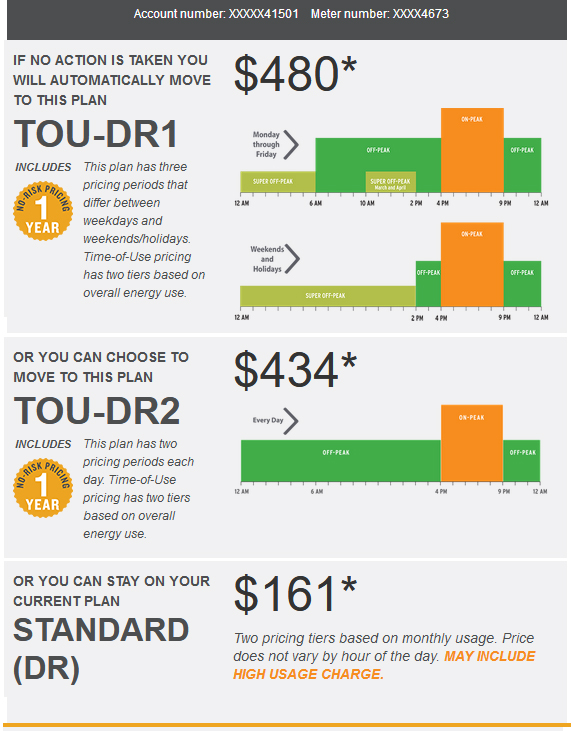This article is from UCAN website March, 2019
What’s Happening?
 SDG&E is launching new electric rate plans, described as “Default Time-of-Use (TOU).” The rates vary by time of day, with a few alternative schedules to choose among (more later). This is different from today’s “Tiered Rates,” which vary based on total energy usage each month. (Pay one rate up to a limit, then higher for more.)
SDG&E is launching new electric rate plans, described as “Default Time-of-Use (TOU).” The rates vary by time of day, with a few alternative schedules to choose among (more later). This is different from today’s “Tiered Rates,” which vary based on total energy usage each month. (Pay one rate up to a limit, then higher for more.)
Under customary Tiered Rates our only way to save money was to use less electricity. With TOU, we can save by shifting usage from expensive “Peak” times – 4 p.m. to 9 p.m. – to cheaper times, “Off-Peak” or “Super Off-Peak.” Careful here: If you use less total energy but use too much of it during Peak, your total power cost can go up. So the decision you make in choosing a rate schedule will make a difference. Fortunately SDG&E provides information for your decision, including the estimated annual impact each plan would have for you.
Some assurance here: SDG&E will be offering bill protection for the first year after a customer is moved to Time-of-Use pricing. This is meant to ensure that customers are not harmed by moving to a new TOU Rate. If a customer’s bills would have been less on the old tiered rate as compared to the new TOU rate, the customer will be protected and will be credited the difference. The protection only applies to the first year.
“Default” is an important word here: You will be placed into the default TOU schedule unless you tell SDG&E differently.
Why Time-of-Use?
Simply stated, it costs more to generate power during peak demand times, so the California Public Utilities Commission says rates should reflect this. Higher cost during higher demand is normal, but we Californians have changed the timing of those peak times during the day. Solar energy has caused big changes in when we demand the most power from SDG&E. Total Power use still peaks in the afternoon hours, but solar power has increasingly handled this peak: SDG&E now sees higher demand for energy from power plants only as the sun goes down.
SDG&E started making the case for new rate schedules in 2015 in their GRC Phase 2 proceeding, and UCAN has been weighing in on the details all along. UCAN did not get everything we wanted from the CPUC, but we got compromises that are more fair to the residential and small business customers. Still, we want to hear from any who feel negatively affected.
What Should You Do Now?
1. Pilot Program participants should already have received information in the mail from SDG&E, and your March 2018 bills should reflect Default TOU rates if you did not choose a different plan. If you do not get – or simply do not open – a paper bill, you may have missed this. For those who will change over next year, keep an eye out.
2. In addition to hard copy bill mailers, SDG&E has online tools that estimate the annual cost of each plan based on your past usage. (An online account is simple and immediate to set up, but you’ll need your account number). Once logged on to your account, look for “Compare Pricing Plans” and click: the site thinks about it for a minute then shows you estimated annual costs of up to 3 new plans available to you.
3. For those who prefer not to go online, you’ll need to rely on SDG&E’s mailers to know your choices: They include printouts of those same estimates you can get online. Do nothing if okay with the default plan, but absolutely return the postal replay card or call SDG&E if you want to stay on Tiered pricing or prefer a plan different from the default option.
4. How to choose a plan, in brief:
• Check your estimated annual costs (from SDG&E) under each plan. The numbers may be very close to one another, in which case you can relax a bit.
- Customers with Solar: TOU makes SDG&E power most expensive right when most solar homes need it! You probably want to stay with a tiered plan, but may see a couple choices.
• Choose the plan that offers savings opportunities you can actually use:
i. Do you use lots of energy during the Peak, 4 p.m. to 9 p.m.? If it has to be during those hours, consider staying with Tiered Rates.
ii. Can you shift usage to morning hours? (“Super Off-Peak” Weekdays: 12 a.m. to 6 a.m.; Weekends: 12 a.m. to 2 p.m.) Default TOU (“TOU-DR1”) gives you the most chances to save.
iii. Are those Super Off-Peak times not useful? You should see another TOU option without Super Off-Peak, but with a long Off Peak schedule.
iv. You may see additional options, but the logic remains: Find the annual estimate for each plan, then figure out which offers the most opportunities to save by changing when you use energy from SDG&E.
Still have questions? Contact SDG&E.
If you cannot get good answers there, call us at: 619-201-6183.


